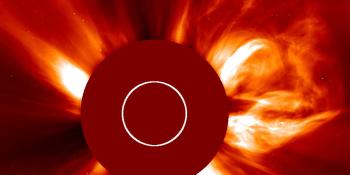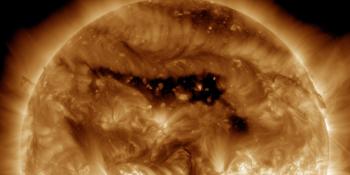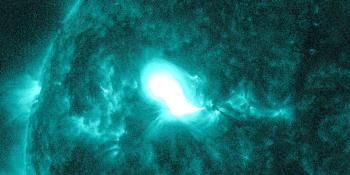Visualizzazione archivio di lunedì, 21 marzo AM
Rapporto attività solare
Ogni brillamento solare menzionato nel rapporto ha un fattore di scala, applicato dal Centro di Predizione Meteorologica Spaziale (SWPC). A causa del fattore di scala del SWPC, i brillamenti solari sono segnalati come ridotti del 42%, rispetto ai dati di qualità scientifica. Il fattore di scala è stato rimosso dai nostri dati archiviati sui brillamenti solari, per riflettere le unità fisiche reali.
Rapporto dell'Attività Geofisica Solare 2011 Mar 21 2200 UTCPreparati dal SWPC della NOAA© ed elaborati da SpaceWeatherLive.com
Rapporto Congiunto USAF/NOAA dell'Attività Solare e Geofisica
SDF Numero 080 Emesso alle 2200Z il Mar 21 2011IA. Analisi delle Regioni Solari Attive e Attività dalle 2100Z-20 alle 2100Z-21 Solar activity increased to low levels. Isolated
C-class flares were observed, the largest of which was a
long-duration C4 at 21/1719Z from newly-numbered Region 1176
(S13E81). Region 1176 was the return of old Region 1165, which
produced M-class flares during its previous rotation. SOHO/LASCO
images showed a halo-CME, first visible in C2 images at 21/0236Z.
The halo-CME was determined to be a backside event associated with a
flare from old Region 1169 (N20, L=061).
IB. Previsione dell'Attività Solare
Solar activity is expected to be low
during days 1 - 3 (22 - 24 March) with a chance for an M-class flare
from Region 1176.
IIA. Sommario dell'Attività Geofisica dalle 2100Z-20 alle 2100Z-21
Geomagnetic field activity was at quiet levels. A greater than 10 MeV
proton event at geosynchronous orbit began at 21/1950Z and was in
progress at the time of this report. Stereo-A EUVI 195 images
indicated the source for the proton event was likely a flare from
old Region 1169 which also spawned the back sided halo-CME mentioned
above.
IIB. Previsione dell'Attività Geofisica
Geomagnetic activity is
expected to be at quiet levels during days 1 - 2 (22 - 23 March).
Geomagnetic activity is expected to increase to quiet to unsettled
levels on day 3 (24 March) as a coronal hole high-speed stream
begins to disturb the field. The greater than 10 MeV event at
geosynchronous orbit is expected to end on day 1 (March 22).
III. Probabilità dell'Evento dalle Mar del 22 alle Mar del 24
| Classe M | 30% | 30% | 30% |
| Classe X | 05% | 05% | 05% |
| Protone | 10% | 01% | 01% |
| PCAF | green | ||
IV. Flusso di 10.7 cm di Penticton
Osservato 21 Mar 101 Previsto 22 Mar-24 Mar 115/125/135 Media di 90 Giorni 21 Mar 094
V. Indici Geomagnetici A
Osservato Afr/Ap 20 Mar 004/004 Stimato Afr/Ap 21 Mar 002/004 Previsto Afr/Ap 22 Mar-24 Mar 005/005-005/005-008/008
VI. Probabilità dell'Attività Geomagnetica dal 22 Mar al 24 Mar
| A. Latitudini Medie | |||
|---|---|---|---|
| Attivo | 10% | 10% | 15% |
| Tempesta minore | 01% | 01% | 05% |
| Tempesta maggiore-grave | 01% | 01% | 01% |
| B. Latitudini Alte | |||
|---|---|---|---|
| Attivo | 15% | 15% | 20% |
| Tempesta minore | 01% | 01% | 10% |
| Tempesta maggiore-grave | 01% | 01% | 01% |
Tutti gli orari in UTC
<< Vai alla pagina della panoramica giornaliera
Ultime notizie
Ultimi messaggi dal forum
AR 13905 47Growth of Cycle 25 760AR13906 16Incoming & Unnumbered Active Regions 1259Coronal mass ejection impact and G4 geomagnetic storm 10 & 11 October 2024 929
Altri argomentiSupporta SpaceWeatherLive.com!
Molte persone vengono su SpaceWeatherLive per seguire l'attività del Sole o sapere se ci sia la possibilità di vedere l'aurora, ma a maggior traffico corrispondono costi maggiori. Considerate una donazione se vi piace SpaceWeatherLive così che possiamo mantenere online il sito web!

Notizie sul meteo spaziale
| Ultimo brillamento X | 2024/11/06 | X2.39 |
| Ultimo brillamento M | 2024/11/24 | M1.0 |
| Ultima tempesta geomagnetica | 2024/11/10 | Kp5+ (G1) |
| Giorni senza macchie | |
|---|---|
| Ultimo giorno senza macchie | 2022/06/08 |
| Media mensile Numero di Macchie Solari | |
|---|---|
| ottobre 2024 | 166.4 +25 |
| novembre 2024 | 144.7 -21.7 |
| Last 30 days | 158.7 +10.9 |


